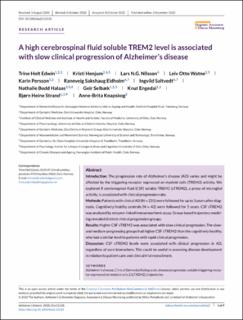| dc.contributor.author | Edwin, Trine Holt | |
| dc.contributor.author | Henjum, Kristi | |
| dc.contributor.author | Nilsson, Lars N. G. | |
| dc.contributor.author | Watne, Leiv | |
| dc.contributor.author | Persson, Karin Ester Torun | |
| dc.contributor.author | Eldholm, Rannveig Sakshaug | |
| dc.contributor.author | Saltvedt, Ingvild | |
| dc.contributor.author | Halaas, Nathalie Bodd | |
| dc.contributor.author | Selbæk, Geir | |
| dc.contributor.author | Engedal, Knut | |
| dc.contributor.author | Strand, Bjørn Heine | |
| dc.contributor.author | Knapskog, Anne Brita | |
| dc.date.accessioned | 2021-01-04T12:59:03Z | |
| dc.date.available | 2021-01-04T12:59:03Z | |
| dc.date.created | 2020-12-23T11:57:36Z | |
| dc.date.issued | 2020 | |
| dc.identifier.issn | 1552-5260 | |
| dc.identifier.uri | https://hdl.handle.net/11250/2721283 | |
| dc.description.abstract | Introduction: The progression rate of Alzheimer's disease (AD) varies and might be affected by the triggering receptor expressed on myeloid cells (TREM2) activity. We explored if cerebrospinal fluid (CSF) soluble TREM2 (sTREM2), a proxy of microglial activity, is associated with clinical progression rate. Methods: Patients with clinical AD (N = 231) were followed for up to 3 years after diagnosis. Cognitively healthy controls (N = 42) were followed for 5 years. CSF sTREM2 was analyzed by enzyme-linked immunosorbent assay. Group-based trajectory modeling revealed distinct clinical progression groups. Results: Higher CSF sTREM2 was associated with slow clinical progression. The slow- and medium-progressing groups had higher CSF sTREM2 than the cognitively healthy, who had a similar level to patients with rapid clinical progression. Discussion: CSF sTREM2 levels were associated with clinical progression in AD, regardless of core biomarkers. This could be useful in assessing disease development in relation to patient care and clinical trial recruitment. Keywords: Alzheimer's disease; Clinical Dementia Rating scale; disease progression; soluble triggering receptor expressed on myeloid cells 2 (sTREM2); trajectories. | en_US |
| dc.language.iso | eng | en_US |
| dc.publisher | Wiley | en_US |
| dc.rights | Attribution-NonCommercial-NoDerivatives 4.0 Internasjonal | * |
| dc.rights.uri | http://creativecommons.org/licenses/by-nc-nd/4.0/deed.no | * |
| dc.title | A high cerebrospinal fluid soluble TREM2 level is associated with slow clinical progression of Alzheimer's disease | en_US |
| dc.type | Peer reviewed | en_US |
| dc.type | Journal article | en_US |
| dc.description.version | publishedVersion | en_US |
| dc.source.volume | 12 | en_US |
| dc.source.journal | Alzheimer's & Dementia | en_US |
| dc.identifier.doi | 10.1002/dad2.12128 | |
| dc.identifier.cristin | 1863059 | |
| dc.description.localcode | This is an open access article under the terms of the Creative Commons Attribution-NonCommercial-NoDerivs License, which permits use and distribution in any medium, provided the original work is properly cited, the use is non-commercial and no modifications or adaptations are made. © 2020 The Authors. Alzheimer’s & Dementia: Diagnosis, Assessment & Disease Monitoring published by Wiley Periodicals, LLC on behalf of Alzheimer’s Association | en_US |
| cristin.ispublished | true | |
| cristin.fulltext | original | |
| cristin.qualitycode | 1 | |

